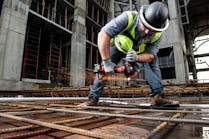The Association of Equipment Manufacturers released a study of the construction, mining, and agriculture equipment manufacturing community that it hopes will help make the case for various federal actions, including an infrastructure bill.
The report, “Market Size and Economic Contributions of the Off-Highway Industry,” studied the economic impact of the equipment manufacturing industry, and determined that it represents 12 percent of all manufacturing jobs in the United States.
“Every day, the 2.8 million men and women of our industry roll up their sleeves and go to work building state-of-the-art equipment in communities across the country,” said Dennis Slater, AEM president, in a prepared statement. “This report tells the story of the people who make America by building the combine the farmer uses to harvest his corn and the excavator the construction worker uses to build our roads and bridges.”
The report was produced by IHS Markit.
The report shows significant overall direct job growth for the industry over the last three years, at a rate of nearly 10 percent, fueled in part by historic tax reform and regulatory relief. However, tariffs on steel and other critical inputs, along with a protracted trade war with China, caused direct job growth to slow to just 1.2 percent in 2019, with both the construction and agriculture equipment sectors contracting by 0.7 and 0.6 percent respectively.
The new report on the economic impact of the equipment manufacturing industry comes as a recent national poll shows that 91 percent of registered voters say manufacturing is critical or important to the U.S. economy. The same poll also shows that more than three-quarters of registered voters want to know how presidential candidates plan to support and grow manufacturing in the United States.
“2020 is an important election year for our industry, and for all manufacturers,” said Jeff Reed, AEM board chair, and president/CEO of Reed International/VSS Macropaver, in a statement. “Voters look to elected officials and candidates to support pro-manufacturing policies. That means supporting free and fair trade, infrastructure investment, strong agricultural communities, and training the next generation of America’s workforce, all of which is critically important to the 2.8 million men and women of our industry.”
The report focuses on several measures of economic value, including the total number of jobs supported by the equipment manufacturing industry and its contribution to the amount of gross domestic product (GDP) of the United States. Highlights include:
- $791 billion dollars a year are generated by equipment manufacturers in total equipment sales and output
- Equipment manufacturing jobs pay 35 percent more than the national average
- Equipment manufacturers support at least 1,000 jobs in 44 states
- Equipment manufacturers support at least 1,000 jobs in nearly two-thirds of every U.S. congressional district
- The top five states with the most jobs supported by the equipment manufacturing industry are Texas (622,882), Illinois (245,624), Wisconsin (187,699), Ohio (163,990), and Indiana (139,842)
To keep equipment manufacturing front and center in 2020, AEM is launching a series of initiatives to educate and engage the men and women of the industry on the policy issues that matter. This includes the “AEM 2020 Manufacturing Express,” a three-month, 20-state bus tour that will highlight the importance of equipment manufacturing to communities across the country, connect manufacturing voters with elected officials and candidates, and promote civic engagement.
In preparing the report, IHS Markit analyzed government data as well as AEM member data. The economic contribution of the industry is measured in terms of employment, output, value added (contribution to GDP), labor income, and tax revenue. For each measure, the direct, indirect, and induced contributions of the industry are calculated using a combination of the IHS Markit Business Market Insights industry model, Regional economic model, Census and StatsCan metrics, and factors derived from the IMPLAN model, an input-output model based on government data.
Source: AEM





